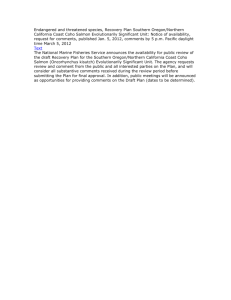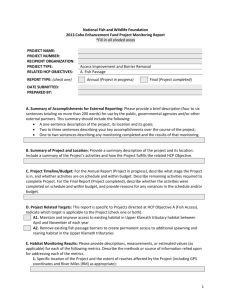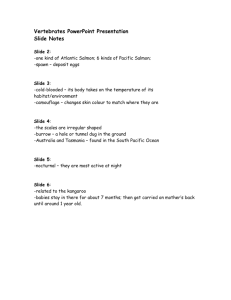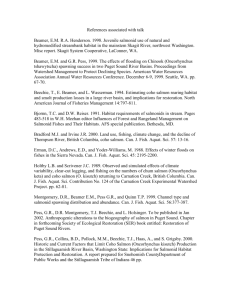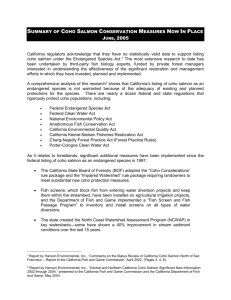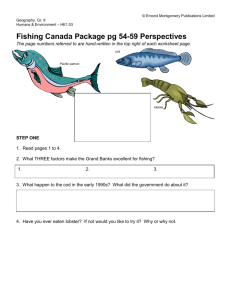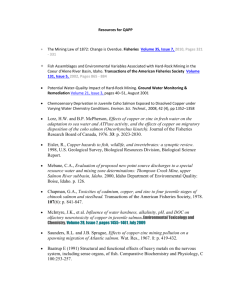Landscape characteristics, land use, and coho Oncorhynchus kisutch Snohomish River, Wash., U.S.A.
advertisement
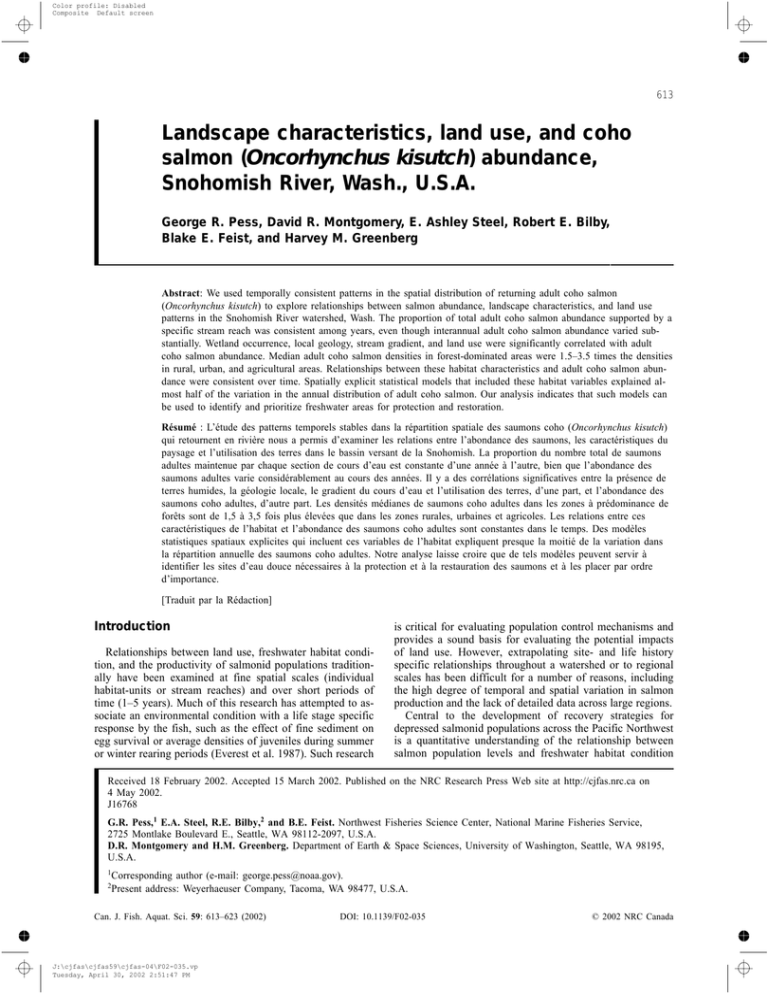
Color profile: Disabled Composite Default screen 613 Landscape characteristics, land use, and coho salmon (Oncorhynchus kisutch) abundance, Snohomish River, Wash., U.S.A. George R. Pess, David R. Montgomery, E. Ashley Steel, Robert E. Bilby, Blake E. Feist, and Harvey M. Greenberg Abstract: We used temporally consistent patterns in the spatial distribution of returning adult coho salmon (Oncorhynchus kisutch) to explore relationships between salmon abundance, landscape characteristics, and land use patterns in the Snohomish River watershed, Wash. The proportion of total adult coho salmon abundance supported by a specific stream reach was consistent among years, even though interannual adult coho salmon abundance varied substantially. Wetland occurrence, local geology, stream gradient, and land use were significantly correlated with adult coho salmon abundance. Median adult coho salmon densities in forest-dominated areas were 1.5–3.5 times the densities in rural, urban, and agricultural areas. Relationships between these habitat characteristics and adult coho salmon abundance were consistent over time. Spatially explicit statistical models that included these habitat variables explained almost half of the variation in the annual distribution of adult coho salmon. Our analysis indicates that such models can be used to identify and prioritize freshwater areas for protection and restoration. Résumé : L’étude des patterns temporels stables dans la répartition spatiale des saumons coho (Oncorhynchus kisutch) qui retournent en rivière nous a permis d’examiner les relations entre l’abondance des saumons, les caractéristiques du paysage et l’utilisation des terres dans le bassin versant de la Snohomish. La proportion du nombre total de saumons adultes maintenue par chaque section de cours d’eau est constante d’une année à l’autre, bien que l’abondance des saumons adultes varie considérablement au cours des années. Il y a des corrélations significatives entre la présence de terres humides, la géologie locale, le gradient du cours d’eau et l’utilisation des terres, d’une part, et l’abondance des saumons coho adultes, d’autre part. Les densités médianes de saumons coho adultes dans les zones à prédominance de forêts sont de 1,5 à 3,5 fois plus élevées que dans les zones rurales, urbaines et agricoles. Les relations entre ces caractéristiques de l’habitat et l’abondance des saumons coho adultes sont constantes dans le temps. Des modèles statistiques spatiaux explicites qui incluent ces variables de l’habitat expliquent presque la moitié de la variation dans la répartition annuelle des saumons coho adultes. Notre analyse laisse croire que de tels modèles peuvent servir à identifier les sites d’eau douce nécessaires à la protection et à la restauration des saumons et à les placer par ordre d’importance. [Traduit par la Rédaction] Pess et al. 623 Introduction Relationships between land use, freshwater habitat condition, and the productivity of salmonid populations traditionally have been examined at fine spatial scales (individual habitat-units or stream reaches) and over short periods of time (1–5 years). Much of this research has attempted to associate an environmental condition with a life stage specific response by the fish, such as the effect of fine sediment on egg survival or average densities of juveniles during summer or winter rearing periods (Everest et al. 1987). Such research is critical for evaluating population control mechanisms and provides a sound basis for evaluating the potential impacts of land use. However, extrapolating site- and life history specific relationships throughout a watershed or to regional scales has been difficult for a number of reasons, including the high degree of temporal and spatial variation in salmon production and the lack of detailed data across large regions. Central to the development of recovery strategies for depressed salmonid populations across the Pacific Northwest is a quantitative understanding of the relationship between salmon population levels and freshwater habitat condition Received 18 February 2002. Accepted 15 March 2002. Published on the NRC Research Press Web site at http://cjfas.nrc.ca on 4 May 2002. J16768 G.R. Pess,1 E.A. Steel, R.E. Bilby,2 and B.E. Feist. Northwest Fisheries Science Center, National Marine Fisheries Service, 2725 Montlake Boulevard E., Seattle, WA 98112-2097, U.S.A. D.R. Montgomery and H.M. Greenberg. Department of Earth & Space Sciences, University of Washington, Seattle, WA 98195, U.S.A. 1 2 Corresponding author (e-mail: george.pess@noaa.gov). Present address: Weyerhaeuser Company, Tacoma, WA 98477, U.S.A. Can. J. Fish. Aquat. Sci. 59: 613–623 (2002) J:\cjfas\cjfas59\cjfas-04\F02-035.vp Tuesday, April 30, 2002 2:51:47 PM DOI: 10.1139/F02-035 © 2002 NRC Canada Color profile: Disabled Composite Default screen 614 Can. J. Fish. Aquat. Sci. Vol. 59, 2002 Fig. 1. Map of the Snohomish River basin on the west slope of the North Cascades in northwestern Washington. Solid black denotes each adult coho salmon index reach. Grey watersheds within the basin denote areas inaccessible to anadromous fishes. (Holtby and Scrivener 1989). Several methods for relating salmonid population response to changes in freshwater habitat condition have been developed in the Pacific Northwest over the past several decades. One approach is based on reach-scale relationships between potential fish capacity and habitat condition (Reeves et al. 1989). Potential fish capacity by life stage is calculated by applying life stage specific salmonid densities and survival estimates to reach-level habitat data for the entire watershed (Beechie et al. 1994). Although this approach can be used to estimate potential salmon population size and spatial distribution, it has not been used for regional analysis because detailed field data are not available across all watersheds. Various methods of stream habitat classification also have been used to predict salmon response to habitat condition. For example, a priori classification of channel types can explain substantial variance in salmonid spawner densities (Montgomery et al. 1999), but other important habitat variables also influence salmonid population dynamics such as stream temperature and flow conditions. In this paper, we develop a broad-scale analysis that correlates coho salmon abundance with habitat characteristics and land use in the Snohomish River Basin of western Washington. Specifically, we combine stream-reach and watershed area characteristics, such as the amount and quality of wetland and floodplain habitat, riparian vegetation, geology, or land use to determine correlations between adult coho salmon (Oncorhynchus kisutch) abundance levels, land use, and the underlying physical features. We address the interannual variation in fish abundance using a hierarchical anal© 2002 NRC Canada J:\cjfas\cjfas59\cjfas-04\F02-035.vp Tuesday, April 30, 2002 2:51:49 PM Color profile: Disabled Composite Default screen Pess et al. ysis strategy in which each year of data is examined independently and the results summarized across years. Materials and methods Study site The 4610-km2 Snohomish River watershed, located in the Puget Sound basin of western Washington, includes the Skykomish and Snoqualmie rivers that flow west from the Cascade range through the glaciated Puget lowlands, forming the mainstem Snohomish at their confluence (Fig. 1). The Snohomish River flows through a broad alluvial floodplain and delta for 33 river kilometers before entering Puget Sound northeast of Seattle, Wash. The basin ranges in elevation from sea level to 2438 meters above sea level (ASL) and has an average annual precipitation range between 762 mm·year–1 at Puget Sound and 4064 mm·year–1 at the crest of the Cascade range. Lower-elevation forests of the drainage (<700 m ASL) are within the western hemlock zone (Franklin and Dyrness 1973). Dominant conifer species are western hemlock (Tsuga heterophylla), Douglas fir (Pseudotsuga menziesii), western red cedar (Thuja plicata), and Sitka spruce (Picea sitchensis). Deciduous broadleaf species include red alder (Alnus rubra), black cottonwood (Populus trichocarpa), and bigleaf maple (Acer macrophyllum). More than 75% of the Snohomish River basin is forested, with the vast majority in upland areas. The floodplains and neighboring foothills along the major river channels are located predominantly in rural-residential, agricultural, and urbanized areas. Nearly all salmon spawning and rearing occurs within the lowelevation western hemlock zone. Returning adult coho salmon enter the Snohomish River from October through January to spawn in their natal streams, which are primarily small, gravel-bedded, low-gradient tributaries. Run timing and population status vary by stock, four of which (Snohomish, Skykomish, South Fork Skykomish, and Snoqualmie) are recognized as distinct stocks by the Washington Department of Fisheries and Wildlife (WDFW) and Western Washington Treaty Indian Tribes (WDFW and Western Washington Treaty Indian Tribes 1993). Coho salmon eggs incubate in spawning gravel through the winter and emerge as fry in March through May. After rearing in freshwater for one to two years, coho salmon smolts migrate to salt water usually during March and April. Most coho in the Snohomish spend 14–18 months in freshwater and 16– 20 months in the Pacific Ocean before returning to spawn at 3 years of age. Approach Our approach included several steps. First, we characterized coho salmon distribution and abundance in the Snohomish River Basin of western Washington. We expressed local adult coho salmon population levels relative to the total population for the entire drainage basin and found strong interannual consistency in the spatial distribution of spawners. Next, we characterized multiple habitat characteristics at both the streamreach and watershed area scales. Finally, we combined the spawner abundance data with the habitat data at each scale to 615 identify relationships between adult coho salmon abundance levels and broad-scale habitat characteristics. Data Fish abundance data used in our analysis were based on annual surveys of spawning coho salmon collected by the WDFW at 54 index stream reaches from 1984 to 1998. The analysis approach we used requires data collected at numerous sites over a long period of time within a basin. The best salmon abundance data available over broad spatial and long temporal scales are adult salmon counts. Thus, our analysis compares adult salmon abundance with physical habitat characteristics. Index reaches averaged 0.90 km in length, and ranged from 0.20 to 3.80 km. Each index reach was surveyed every 7–10 days from the beginning of November through January over the entire period of record. Abundance of spawners at the index reaches was reported as fish-days. Fish-days were calculated by multiplying the live fish observed on each survey date by the number of days between surveys. These values were then summed for the entire observation period to generate a relative index of spawner abundance at a reach for any given year. Habitat geospatial data layers used in the analysis were characterized at two spatial scales: the reach and watershed. Habitat attributes were explored at two scales because the effects of certain factors on salmon are likely to be limited to the area immediately adjacent to the channel (reach scale), whereas the effect of other factors depends on upstream conditions (watershed scale). For example, a loss of forested riparian area may have a greater effect on reach-scale wood recruitment and subsequently reach-scale habitat characteristics (such as the loss of pools), whereas the influence of local geology on overall sediment input into the reach can only be captured on a watershed scale. Reach-level habitat data were delineated for the area within 100 m of the channel edge for each index reach and watershed-level data included the entire drainage area contributing to the downstream end of the index reach (Table 1; Fig. 2). Habitat data were determined for the index reaches by locating each reach on a 1 : 24 000 scale digital hydrographic data layer developed by the Washington Department of Natural Resources. At each spatial scale, a wide array of habitat geospatialrelated datalayers that represented natural (or landform variables) and anthropogenic (or land cover variables) characteristics were analyzed. All habitat data, with the exception of the potential for slope instability, were derived from existing data sources (Table 1). Potential for slope instability, a variable relating to sediment delivery to the index reach, was generated by a model that uses hill-slope gradient, drainage area, and slope form derived from a 10-m digital elevation model to estimate the relative potential for shallow landsliding (Montgomery and Dietrich 1994). Habitat data for the stream reach and watershed included geology (Booth 1990a), wetland abundance and type (Cowardian et al. 1979), wetland modification (defined as hydrologically altered wetlands that had been ditched or separated from the stream channel by bank armoring or diking) (Cowardian et al. 1979), land cover classification (forest, agriculture, rural, and urban), and the relative potential for slope instability. © 2002 NRC Canada J:\cjfas\cjfas59\cjfas-04\F02-035.vp Tuesday, April 30, 2002 2:51:50 PM Color profile: Disabled Composite Default screen 616 Can. J. Fish. Aquat. Sci. Vol. 59, 2002 Table 1. Summary table of stream reach and watershed-scale landform and land use data layers used in habitat analysis for the Snohomish River Basin, Washington. Data layer Source (year) a Surficial geology Booth (1990 ) Wetlands United States Fish and Wildlife Service National Wetlands Inventory (Cowardian et al. 1979) Montgomery and Dietrich (1994) Potential for slope instability Land use and (or) land cover Puget Sound Regional Council LANDSATTM thematic mapper (1992) Grid cell size/resolution Category Scale Description vashon till advance outwash recessional outwash undifferentiated drift alluvium bedrock peat % wetlands 1 : 100 000 Vector data/polygons Classification of geologic map units according to major surficial geology. All bedrock types were grouped together. 1 : 58 000 Vector data/polygons Classification of wetland types from aerial photo analysis. 10 m Relative index of topographic control on shallow landslide potential. 30 m Classification of LANDSATTM imagery into land cover categories developed from 1992 LANDSATTM imagery. wetland class steady state rainfall values necessary to trigger slope failure forest rural residential agriculture urban roads Fig. 2. An example of the stream-reach and watershed area spatial analysis in the Snohomish River basin. Thick, solid, grey lines indicate 100-m buffer around index reaches. Broken black line denotes drainage area to an index reach. Data analysis We examined the relationships between habitat characteristics and fish abundance using a simplified hierarchical linear model (HLM) (Bryk and Raudenbush 1992). Hierarchical models are common in the social sciences for modeling nested social units; for example, students within classrooms (Bryk and 1 : 100 000 Raudenbush 1992). We used it here to describe nested observations: spawner counts within years. In biometric applications, these models are often called mixed- or random-effects models (Laird and Ware 1982). We used a simplified version of the hierarchical linear model because we were limited to only one estimate of fish abundance per site per year. We examined the data using exploratory single-variable and multiple-regression models. In both cases, our analysis consisted of two steps. In the first step, we fit a weighted, log-linear model to each year of data independently; the model explained variation in fish density as a function of single habitat characteristics (for the exploratory analyses) or suites of habitat characteristics (for the explanatory models). Models were weighted by the inverse of the coefficient of variation in fish-days to reduce the impact of highly variable sites on the model parameters. In the second step, the distribution of regression coefficients over all years was examined for consistent patterns. Because of small sample sizes and concerns about distributional assumptions, the statistical significance of the pattern of regression coefficients was assessed using a randomization test (Good 1994). The observed t statistic, which tested whether or not the mean regression coefficient (over all years) was significantly different from zero, was compared with 1000 t statistics calculated from random permutations of the dependent variable (within year). An exact P value was calculated and expressed as the percent of t statistics from the permuted data sets that were more extreme than the observed t statistic. We used an alpha level of 0.002 to indicate a significant relationship. A conservative cutoff was chosen because of the multitude of statistical tests required to explore all potential predictors. We tested for sites with particularly high leverage, the ability to affect the regression coefficients dramatically, using a leave-one-out approach. No single site was responsible for the consistent patterns in regression coefficients over time. To identify the suite of habitat characteristics most closely © 2002 NRC Canada J:\cjfas\cjfas59\cjfas-04\F02-035.vp Tuesday, April 30, 2002 2:51:50 PM Color profile: Disabled Composite Default screen Note: Bolded numbers in upper right (above the diagonal) are reach-scale variables. Numbers in lower left (below the diagonal) are watershed-scale variables. For those variables that were transformed in the analysis (Table 3), correlations are presented for the transformed data. 0.13 –0.88 0.70 0.33 0.06 –0.68 0.59 0.10 0.42 –0.03 –0.18 –0.50 –0.13 –0.46 0.16 0.04 0.17 0.01 0.28 0.09 –0.30 –0.18 0.41 0.20 0.17 –0.66 –0.34 –0.22 0.55 –0.57 –0.14 –0.21 0.09 –0.03 0.36 –0.11 0.11 –0.07 –0.42 0.50 –0.06 0.23 0.00 –0.04 –0.37 –0.10 0.47 –0.21 0.20 –0.15 0.28 0.41 –0.09 –0.24 0.27 0.07 0.22 –0.07 –0.27 –0.07 0.20 0.29 0.31 –0.39 –0.11 –0.59 –0.12 0.36 0.62 0.06 –0.18 0.34 –0.08 –0.24 –0.36 0.05 –0.31 –0.12 –0.12 –0.01 –0.13 0.23 –0.61 –0.84 –0.06 –0.03 –0.21 0.27 0.52 0.23 0.03 –0.08 –0.09 –0.14 0.21 0.18 –0.33 0.03 0.31 –0.13 –0.14 0.05 0.08 0.12 0.07 0.01 0.00 –0.05 0.06 –0.11 –0.18 –0.10 0.10 –0.11 0.17 –0.17 0.19 –0.10 –0.13 0.08 0.29 –0.21 –0.03 0.02 0.37 0.05 –0.02 –0.55 –0.45 –0.19 –0.19 –0.19 –0.15 0.25 –0.13 0.15 –0.09 0.32 –0.11 0.11 0.03 –0.23 –0.10 –0.44 0.42 0.01 –0.17 –0.13 0.17 –0.05 –0.30 0.35 –0.03 0.06 –0.11 –0.07 0.04 –0.28 –0.13 –0.26 0.28 0.43 0.06 –0.23 0.26 0.24 –0.12 0.07 –0.09 –0.16 –0.20 0.36 –0.03 –0.19 –0.22 –0.14 –0.18 0.00 0.08 –0.02 0.27 0.06 0.08 –0.10 –0.09 0.06 0.18 0.21 –0.18 –0.12 –0.41 –0.53 –0.66 0.12 –0.09 0.34 0.58 0.32 –0.70 0.41 0.06 0.17 –0.24 0.27 0.33 –0.09 –0.09 0.14 –0.01 0.15 Urban Rural Agriculture Forest Roads Wetland Water Unstable slopes Advanced outwash Recessional outwash Till Peat Alluvium Bedrock Drainage area Bedrock Alluvium Peat Till Recessional outwash Advanced outwash Unstable slopes Water Wetland Roads Forest Agriculture HLM analysis Hierarchical linear modeling of the habitat variables against fish abundance revealed temporally consistent, statistically significant relationships for a number of stream-reach and watershed-scale variables (Figs. 4a and 4b; Table 3). At both the reach and watershed scales, there were negative correlations over time between coho abundance and the percentage of the area that is in urban and agricultural use, and positive correlations over time with the percentage of the area forested. Surficial geology also was related to salmon abundance. The percent of the drainage basin or riparian area underlain by shallow bedrock had a negative correlation at both spatial scales. In contrast, the proportion of peat and glacial till was positively related to salmon abundance at the watershed scale and peat was also positively correlated at the reach scale. Although there appear to be trends through time for some of the regression coefficients, few are significant, and in all but two cases, those trends that are significant are weak. In only two cases (percent recession outwash and percent potentially unstable slopes) was the ratio of the slope of the time trend over the mean regression coefficient Rural Adult coho salmon distribution and abundance The proportion of total coho salmon abundance supported by particular index reaches in the Snohomish River basin was consistent over time, even though adult coho salmon return levels varied by a factor of three (Fig. 3). Relatively few reaches supported a large proportion of the fish. The 25% of the index reaches with the highest average abundance of spawning salmon accounted for nearly 50% of the fish counted in the index reaches. In contrast, the 25% of the index reaches with the fewest salmon on average supported less than 5% of the spawning coho salmon. Urban Results Table 2. Correlations between each of the potential predictor variables at the stream reach and watershed scales. associated with the sites that had the highest salmon abundance, we constructed a multiple regression model of salmon spawner abundance. Independent multiple regression models were developed using the stream-reach and watershed data. We examined only the main effects of habitat predictors because of our limited sample size and large number of potential predictors. Because of moderate correlation between potential predictors at both the reach and the watershed scale (Table 2), individual regression coefficients in the multiple regression context should be interpreted with caution; inference should be made about the suite(s) of habitat characteristics significantly associated with spawner abundance. Models were fit independently to each year of data and the behavior of the set of regression coefficients was analyzed over time. Coefficients in the final model were calculated as the mean of the coefficients from the independent annual models. The set of predictors used in the model was chosen using a backward and forward selection process. Final model selection was based on total adjusted r 2 (over all years), minimum adjusted r 2 (in any particular year), and statistical significance of all regression coefficients. For the reach-scale model, differences between model performance did not provide a clear break between one or two best models and the other possible models. As a result, we chose to present a set of best models. 617 Stream gradient Pess et al. © 2002 NRC Canada J:\cjfas\cjfas59\cjfas-04\F02-035.vp Tuesday, April 30, 2002 2:51:51 PM Color profile: Disabled Composite Default screen 618 Can. J. Fish. Aquat. Sci. Vol. 59, 2002 Fig. 3. Percentage of adult coho salmon returns (in fish-days) per kilometre of stream length to each index site (1984 to 1998). Open squares are median values; top and bottom of open rectangles are the 25th and 75th percentiles, respectively; horizontal lines at the top and bottom are 5th and 95th percentiles, respectively; and open circles are outliers. greater than 1; in nearly all other cases this ratio was less than 0.2. Although there may be some subtle shifts in the effects of certain habitat variables over time, these shifts are minor when compared with the magnitude of the correlation of the habitat variable. Three predictive models were developed at the reach scale, using different combinations of habitat variables (Table 4). The three models explained similar amounts of the variability in salmon spawner abundance. One model was developed at the watershed scale. Model fit ranged between an adjusted multiple r 2 of 0.20 to 0.42 (Fig. 5). Land-use variables were major factors in all of the final models at both spatial scales. Land cover and landscape variables The magnitude of the correlation of some of the land use variables on salmon abundance becomes clear when relative abundance is plotted against these attributes. Index reaches bordered by lands designated as forest supported far more fish than areas under other types of land use. Average adult coho salmon abundance increased with an increase in proportion of the streamside area in forest at the reach scale (Fig. 6a). Average adult coho salmon abundance in index reaches where more than 50% of the riparian area was designated as forest land was 1.5–3.5× greater than in index reaches with less than 50% forest. In addition, the 10 index reaches supporting the highest salmon abundance were forested over 60% of the riparian area (Fig. 6a). Average coho salmon abundance was positively correlated with amount of forest at the watershed scale (Fig. 6b). An increase in percent total area of other land use categories (e.g., rural, agriculture, urban) at the reach and watershed scales was negatively correlated with adult coho salmon abundance. Salmon abundance was two to three times greater in index reaches that had less than 10% of the contributing watershed in agriculture (Fig. 6c). Discussion Implications of correlating habitat characteristics and adult coho salmon distribution and abundance Our analysis provides a method to identify which habitat attributes correlate with the greatest adult coho salmon abundance and identifies their location based on 14 years of record. Even though substantial variability in salmon abundance remained unexplained by our multivariate models, our model fit was similar to what others have found linking more site-specific habitat variables to coho response (Rosenfield et al. 2000). Our results show that adult coho abundance is correlated to a suite of habitat characteristics shared by sites across space and time, despite interannual variation in population size. Given the high degree of spatial variability in salmon abundance, our results indicate that population monitoring should occur at multiple sites representative of the range of conditions occurring in the watershed. The consistency between these correlative results and our mechanistic understanding of the relationship between salmonids and their habitats suggest that these patterns will remain consistent over time. Our study also demonstrates the utility of this approach for evaluating the role of habitat conditions on salmon abundance. Understanding the habitat characteristics of a watershed associated with the spatial distribution of salmon abundance © 2002 NRC Canada J:\cjfas\cjfas59\cjfas-04\F02-035.vp Tuesday, April 30, 2002 2:51:52 PM Color profile: Disabled Composite Default screen Pess et al. 619 Fig. 4. Relationships of individual predictors at (a) the stream-reach scale and (b) the watershed scale to the natural log of fish-days over time. The y axis describes the mean regression coefficient ± 2 SE for natural log of fish-days as a function of one independent variable. All variables are calculated as a percent of the watershed area of influence except drainage area (km2), roads (road density in km·km–2), and stream channel gradient. Stream channel gradient was calculated as the elevation change (m) divided by index reach length (m) multiplied by 100, and was determined for each index reach using 1 : 24 000 scale United States Geological Survey (USGS) quadrangle maps. Wetland modification was determined by the United States Fish and Wildlife Service (USFWS) National Wetlands Inventory (NWI). © 2002 NRC Canada J:\cjfas\cjfas59\cjfas-04\F02-035.vp Tuesday, April 30, 2002 2:51:52 PM Color profile: Disabled Composite Default screen 620 Can. J. Fish. Aquat. Sci. Vol. 59, 2002 Table 3. Summary of exploratory analysis results. Watershed scale Reach scale Variable Transformation Mean P value Mean P value Urban Rural Agriculture Forest Roads Percent wetlands Nonmodified wetland Wetland Channel gradient Lowest channel gradient Water Partially unstable ground Advance outwash Recessional outwash Till Peat Alluvium Bedrock Drainage area log(x + 0.001) –0.222 0.005 –0.622 0.026 0.083 0.128 0 0.390 0 0 0.412 0.088 –0.180 –0.016 0.049 –0.001 0.016 0.749 –0.103 –0.023 –0.066 0 0.670 0.634 0.680 0 0 0.030 0 0 –0.065 0.003 –0.282 0.025 0.274 0.229 0.638 0.543 0.661 0.102 0.162 0.080 0.157 0.001 0.013 0.803 –0.055 –0.186 0.022 0.394 0 0 0 0.018 0 0 0 0.320 0.010 0.008 0.178 0.742 0.004 0.002 0.110 0 log(x + 0.1) Square root Indicator (1 = non-modified) Indicator (1 = wetland) Square root log(x + 0.01) log(x + 0.001) Indicator AdvOut <0.1 Indicator peat <0.1 log(x + 0.0001) Note: Independent variables were transformed to stabilize the variance by the function identified in the transformation column. The mean columns describe the mean coefficient over all years for linear regression models using only one independent variable to predict the natural log of adult coho returns·km–1. P values are from randomization tests (1000 iterations). Table 4. Reach- and watershed-scale predictive models. Area of influence Equation Reach = = = = Watershed 3.89 – 0.18 · %bedrock + 0.27 · roads (km·km–2) + 0.028 · %forest 378 – 0.25 · ln(%agriculture + 0.01) + 0.22 · %bedrock + 0.56 · sqrt(gradient(m·m–1)) + 1.29 · I(%peat > 0.1) 3.14 + 0.027 · %forest + 0.32 · roads (km·km–2) + 0.26 · sqrt(%wetlands) 6.49 – 0.32 · ln(%agriculture + 0.01) – 0.011·%till 0.029 · %bedrock0.13 · ln(%urban + 0.001) Note: Response variable is the natural log of adult coho returns (fish days)·km–1. I stands for indicator of peat. Fig. 5. Adjusted r-squared values for the four predictive models. Filled circles denote watershed model. Open squares denote average for three reach models. © 2002 NRC Canada J:\cjfas\cjfas59\cjfas-04\F02-035.vp Tuesday, April 30, 2002 2:51:53 PM Color profile: Disabled Composite Default screen Pess et al. 621 Fig. 6. (a) Average adult coho salmon return per kilometre of stream length per year in fish-days versus percent of 100-m buffer that was forested. Regression equation is average adult coho salmon per kilometre of stream length per year = 513 + 32.7(% of 100-m forested buffer) (r 2 = 0.22, P = 0.007). (b) Average adult coho salmon return per kilometre of stream length per year in fish-days versus percent of total upstream drainage area that was forested. Regression equation is average adult coho salmon per kilometre of stream length per year = –824 + 45.3(% total upstream drainage area that is forested) (r 2 = 0.28, P = 0.02). (c) Percent of total drainage area upstream of index reach that was agricultural and average adult coho salmon per kilometre of stream length per year in fish-days. Regression equation is average adult coho salmon per kilometre of stream length per year = 3007 – 89.6 (% of total drainage area that was agricultural) (r 2 = 0.28, P = 0.04). provides a means of prioritizing areas for protection or restoration based on their contribution to overall abundance levels. For example, this approach could either be used to identify sites with potentially greater abundance levels that are currently impaired by land use or be used to identify existing high-abundance areas with a high risk of habitat degradation in the future. Restoration activities could also be prioritized to first address those impaired locations with the appropriate habitat attributes to support high salmon abundance. For example, in the Snohomish River basin, these priority restoration sites would include forested locations with wetlands that have been modified. Maintaining and restoring these sites is considered critical to the long-term recovery of salmonids in the watershed, especially during periods when ocean conditions are unfavorable (Bradford and Irvine 2000). Temporal changes in adult coho salmon distribution and abundance The variability explained by the models differed dramatically among years, suggesting that fish are distributing themselves differently in different years. It is also possible that changes over time in those habitat variables included in the model might contribute to variability in model fit. Such changes would be found in the land-use variables, percentagricultural area, percent-urbanized area, percent-forested area, and road density. A time-series of remotely sensed data describing changes in land use over the entire basin might be used to test this possibility. The low correlation coefficients of the models also suggest that variables for which no data were available may play a role in determining abundance patterns for different reaches. These patterns might be influenced by habitat factors that vary annually (e.g., flow, water temperature) or by the influence of variables other than large-scale habitat characteristics such as ocean conditions. Landscape characteristics, land use, and adult coho salmon distribution and abundance The correlations between landform and coho salmon abundance that we detected are consistent with our understanding of how underlying physical attributes can influence fish habitat potential. Geology and geomorphic processes dictate the range of morphological characteristics a stream reach can exhibit, thus partially determining the physical and biological characteristics of fish habitat (Montgomery and Buffington 1998). We suspect that in the Snohomish Basin areas dominated by bedrock terrain generally produce channels that are too steep to support spawning habitat for coho salmon. Steep channels also lack the pool habitat favored by coho salmon for rearing (Bisson et al. 1982) and often possess very limited amounts of gravel used by the fish for spawning (Beechie and Sibley 1997). The relationship between spawner abundance and landuse activities also indicates that adult coho densities reflect large-scale land-use patterns. We found that forested areas © 2002 NRC Canada J:\cjfas\cjfas59\cjfas-04\F02-035.vp Tuesday, April 30, 2002 2:51:53 PM Color profile: Disabled Composite Default screen 622 maintained positive correlations to spawner abundance, whereas those converted for agricultural or urban uses had negative correlations to spawner abundance. Wetlands and other indicators of wetland environments, like peat, also had consistent positive correlations to spawner abundance. Human disturbances, such as agriculture and urbanization, can lead to a decrease in coho salmon habitat availability and quality (Beechie et al. 1994; Bradford and Irvine 2000). A study in the nearby Skagit River watershed revealed a decrease in tributary and off-channel habitats (e.g., wetlands, sloughs, and ponds) of up to 75%, almost all of which was due to deliberate modifications of the channel and floodplain (Beechie et al. 1994). The vast majority of these impacts are related to the conversion of forested areas to agricultural and subsequently to residential use. Maintained channelization can increase channel incision to the point where the streambed is disconnected from its floodplain (Booth 1990b). Floodplain isolation reduces the amount of off-channel habitat available for adult salmonid spawning and juvenile rearing, which can lead to the downstream displacement of newly emerged salmonids to less-desirable habitats (Seegrist and Gard 1972; Erman et al. 1988). Stream cleaning and riparian vegetation removal reduces the amount of in-channel wood, leading to a loss of pool habitat quantity (Montgomery et al. 1995; Collins et al. 2002), which can substantially reduce coho redd density (Montgomery et al. 1999). Urbanization can lead to an increase in impervious surface area and increase stream-flooding frequency and magnitude (Hollis 1975). The pre-urbanized 10-year recurrence interval flow event can occur every 2–5 years in urbanized areas of the Puget Sound region (Booth 1990b), which can lead to declines in adult coho (Moscrip and Montgomery 1997). Urban watersheds also generate high concentrations of compounds that are toxic to salmon or alter their behavior in ways that could reduce survival (Scholz et al. 2000). Acknowledgements We thank Don Hendrick, Larry Lowe, and Curt Kraemer of the Washington Department of Fish and Wildlife for giving us the spawner survey data and showing us many of the spawner survey index reaches. We thank Dick Gersib and Susan Grigsby of the Washington State Department of Ecology for providing many of the GIS data layers. We thank Peter Kiffney, Phil Roni, Bill Reichert, John Stein, Jason Dunham, and one anonymous reviewer for providing constructive comments on earlier versions of the manuscript. References Beechie, T.J., Beamer, E., and Wasserman, L. 1994. Estimating coho salmon rearing habitat and smolt production losses in a large river basin, and implications for restoration. N. Am. J. Fish. Manag. 14: 797–811. Beechie, T.J., and Sibley, T.H. 1997. Relationships between channel characteristics, woody debris, and fish habitat in northwestern Washington streams. Trans. Am. Fish. Soc. 126: 217–229. Bisson, P.A., Nielson, R.A., Palmason, R.A., and Gore, L.E. 1982. A system of naming habitat types in small streams with examples of habitat utilization by salmonids during low stream flow. In Acquisition and utilization of aquatic habitat information. Edited by N.A. Armatrout. American Fisheries Society, Bethesda, Md. pp. 62–73. Can. J. Fish. Aquat. Sci. Vol. 59, 2002 Booth, D.B. 1990a. Surficial geologic map of the Skykomish and Snoqualmie rivers area, Snohomish and King counties, Washington. U.S. Department of the Interior, U.S. Geological Survey, miscellaneous investigations series, Map I-1745. Denver, Colo. Booth, D.B. 1990b. Stream channel incision following drainage basin urbanization. Water Resour. Bull. 26: 407–417. Bradford, M.J., and Irvine, J.R. 2000. Land use, fishing, climate change, and the decline of Thompson River, British Columbia, coho salmon. Can. J. Fish. Aquat. Sci. 57: 13–16. Bryk, A.S., and Raudenbush, S.W. 1992. Hierarchical linear models. Sage publications, Newbury Park, Calif. Collins, B.D., Montgomery, D.R., and Haas, A. 2002. Historical changes in the distribution and functions of large wood in Puget Lowland rivers. Can. J. Fish. Aquat. Sci. 59: 66–76. Cowardian, L.M., Carter, V., Golet, F.C., and LaRoe, E.T. 1979. Classification of wetland and deepwater habitats of the United States. FWS/OBS-79/31. U.S. Fish and Wildlife Service, U.S. Department of the Interior. Washington, D.C. Erman, D.C., Andrews, E.D., and Yoder-Williams, M. 1988. Effects of winter floods on fishes in the Sierra Nevada. Can. J. Fish. Aquat. Sci. 45: 2195–2200. Everest, F.H., Beschta, R.L., Scrivener, J.C., Koski, K.V., Sedell, J.R., and Cederholm, C.J. 1987. Fine sediment and salmonid production – a paradox. In Streamside management and forestry and fishery interactions. Edited by E. Salo and T. Cundy. University of Washington, College of Forest Resources, Contribution 57, Seattle, Wash. pp. 98–142. Franklin, J.F., and Dyrness, C.T. 1973. Natural vegetation of Oregon and Washington. U.S. For. Serv. Gen. Tech. Rep. PNW-8. Good, P. 1994. Permutation tests: a practical guide to resampling methods for testing hypotheses. Springer-Verlag, New York. Hollis, G.E. 1975. The effects of urbanization on floods of different recurrence intervals. Water Resour. Res. 11: 431–435. Holtby, L.B., and Scrivener, J.C. 1989. Observed and simulated effects of climate variability, clear-cut logging, and fishing on the numbers of chum salmon (Oncorhynchus keta) and coho salmon (O. kisutch) returning to Carnation Creek, British Columbia. Can. J. Fish. Aquat. Sci. Contrib. No. 124 of the Carnation Creek Experimental Watershed Project. pp. 62–81. Laird, N.M., and Ware, H. 1982. Random effects models for longitudinal data. Biometrics, 38: 963–974. Montgomery, D.R., and Buffington, J.M. 1998. Channel processes, classification, and response potential. In River ecology and management. Edited by R.J. Naiman and R.E. Bilby. Springer-Verlag Inc., New York. pp. 13–42. Montgomery, D.R., and Dietrich, W.E. 1994. A physically based model for the topographic control on shallow landsliding. Water Resour. Res. 30: 1153–1171. Montgomery, D.R., Buffington, J.M., Smith, R.D., Schmidt, K.M., and Pess, G.R. 1995. Pool spacing in forest channels. Water Resour. Res. 31:1097–1105. Montgomery, D.R., Beamer, E.M., Pess, G.R., and Quinn, T.P. 1999. Channel type and salmonid spawning distribution and abundance. Can. J. Fish. Aquat. Sci. 56: 377–387. Moscrip, A.L., and Montgomery, D.R. 1997. Urbanization, flood frequency, and salmon abundance in Puget lowland streams. J. Am. Water Resour. Assoc. 33: 1289–1297. Reeves, G.H., Everest, F.H., and Nickelson, T.E. 1989. Identification of physical habitats limiting the production of coho salmon in western Oregon and Washington. U.S. For. Serv. Gen. Tech. Rep. PNW-GTR-245. Rosenfield, J., Porter, M., and Parkinson, E. 2000. Habitat factors affecting the abundance and distribution of juvenile cutthroat © 2002 NRC Canada J:\cjfas\cjfas59\cjfas-04\F02-035.vp Tuesday, April 30, 2002 2:51:54 PM Color profile: Disabled Composite Default screen Pess et al. trout (Oncorhynchus clarki) and coho salmon (Oncorhynchus kisutch). Can. J. Fish. Aquat. Sci. 57: 766–774. Scholz, N.L., Truelove, N.K., French, B.L., Berejikian, B.A., Quinn, T.P., Casillas, E., and Collier, T.K. 2000. Diazinon disrupts anitpredator and homing behaviors in Chinook salmon (Oncorhynchus tshawytscha). Can. J. Fish. Aquat. Sci. 57: 1911–1918. Seegrist, D.W., and Gard, R. 1972. Effects of floods on trout in Sagehen Creek, California. Trans. Am. Fish. Soc. 101: 478–482. 623 Washington Department of Fisheries and Wildlife (WDFW) and Western Washington Treaty Indian Tribes. 1993. Washington State salmon and steelhead stock inventory (SASSI): appendix 1. Puget Sound stocks, north Puget Sound volume. Washington Department of Fisheries and Wildlife. Olympia, Wash. © 2002 NRC Canada J:\cjfas\cjfas59\cjfas-04\F02-035.vp Tuesday, April 30, 2002 2:51:54 PM
